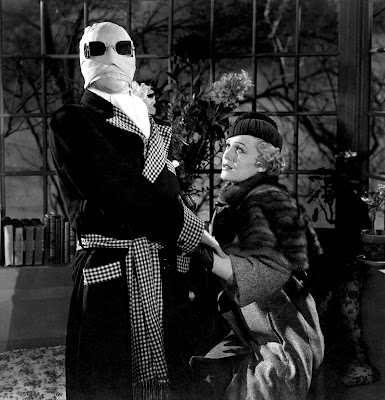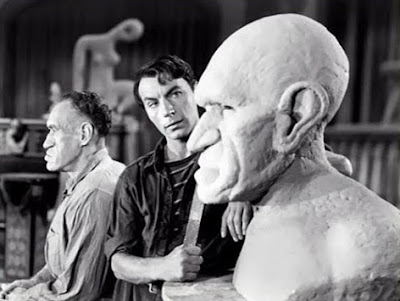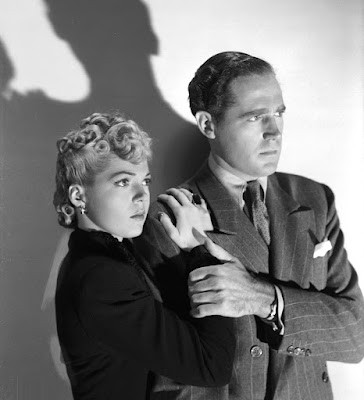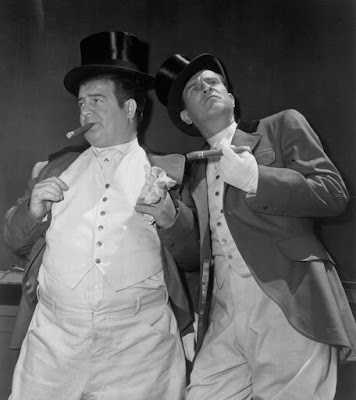As part of the effort to promote "The Mad Ghoul" (1943), actress Evelyn Ankers posed with co-star David Bruce and a post containing the titles of all the movies she'd been in for Universal Pictures up to that point.
Over the years, we've written reviews of all seven of those films, so we took Ankers' post as a rationale to make a post of our own that re-presents those reviews. (Even better, the post inspired by the post with seven reviews is appearing on the 7th day of the month!)
Perhaps you can find this a helpful resource for choosing your inspirational viewing this Halloween Season!
The Mad Ghoul (1943)
Starring: George Zucco, David Bruce, Evelyn Ankers, Turhan Bey, and Robert Armstrong
Director: James Hogan
Rating: Seven of Ten Stars
College chemistry professor Alfred Morris (Zucco) re-discovers a formula for a gas that ancient Central Americans used turn people into pseudo-living zombies, as well as a means for reversing the transformation. He uses his assistant, Ted (Bruce), as an unwitting human test subject while trying to put the moves on Ted's opera-singing fiance (Ankers)... but when the antidote for the gas turns out to only be temporary, Morris's life and Ted's pseudo-undeath become a lot more complicated.
"The Mad Ghoul" is a horror film from Universal Pictures--the studio that bought the world "The Mummy", "Dracula", and "Frankenstein"--that sounds like a film from Monogram or PRC, with its mad scientist with an even madder scheme, a young couple being threatened by evil, and a crusading reporter who is going to stop the monster the police have been unable to catch.
What the writers and director does with those elements are a great change of, though: The crusading reporter ends up, the young couple's romance is revealed to have been over even before the film starts, and the mad doctor's mad scheme keeps getting more insane, first because he was cocky and had to cover up a failed experiment and then because he wanted to remove all rivals for the woman with whom he believes he shares a mutual attraction. (Some of my favorite parts of the film is when George Zucco and Evelyn Ankers' characters are talking past each other; Zucco thinks they are expressing their love for each other while Ankers thinks she's just unloading her sorrows to a sympathetic ear. These scenes feature some nice acting and even better writing, because they perfectly communicate the notion that Zucco's character later expresses, after he realizes he was mistaken: "Sometimes we see what we want to see.")
The cast of "The Mad Ghoul" all provide good performances. Zucco is in particularly fine form, playing the crazed heavy he specialized in but with a tiny bit of nuances thrown in. Robert Armstrong is also fun as the "I'm smarter than the cops" newsman who populates films of this type, and while I saw his brutal end coming before it actually happened, I was a little sad to see him go. Meanwhile, Ankers and Bey play the kinds of characters they portrayed in many other films, and they do it with their usual skill. Finally, David Bruce, in one of his few starring roles, is good as what initially comes across as the standard, fairly bland romantic lead, but becomes an increasingly interesting and nuanced character as the film unfolds.
What the writers and director does with those elements are a great change of, though: The crusading reporter ends up, the young couple's romance is revealed to have been over even before the film starts, and the mad doctor's mad scheme keeps getting more insane, first because he was cocky and had to cover up a failed experiment and then because he wanted to remove all rivals for the woman with whom he believes he shares a mutual attraction. (Some of my favorite parts of the film is when George Zucco and Evelyn Ankers' characters are talking past each other; Zucco thinks they are expressing their love for each other while Ankers thinks she's just unloading her sorrows to a sympathetic ear. These scenes feature some nice acting and even better writing, because they perfectly communicate the notion that Zucco's character later expresses, after he realizes he was mistaken: "Sometimes we see what we want to see.")
The cast of "The Mad Ghoul" all provide good performances. Zucco is in particularly fine form, playing the crazed heavy he specialized in but with a tiny bit of nuances thrown in. Robert Armstrong is also fun as the "I'm smarter than the cops" newsman who populates films of this type, and while I saw his brutal end coming before it actually happened, I was a little sad to see him go. Meanwhile, Ankers and Bey play the kinds of characters they portrayed in many other films, and they do it with their usual skill. Finally, David Bruce, in one of his few starring roles, is good as what initially comes across as the standard, fairly bland romantic lead, but becomes an increasingly interesting and nuanced character as the film unfolds.
Starring: Robert Paige, Frank Craven, Louise Allbritton, Lon Chaney, Jr., Evelyn Ankers, and J. Edward Bromberg
Director: Robert Siodmak
Steve's Rating: Seven of Ten Stars
Eccentric southern belle Katherine Caldwell (Allbritton) apparently falls under the sway of a mysterious Transylvanian nobleman, Alucard (Chaney), while traveling in Europe. When he arrives in the United States, strange deaths start happening, and isolates himself and Katherine in her manorhouse on Darkwood Plantation. But after she is accidentially shot to death by her fiance (Paige), the true horror of what Katherine's plans start to emerge.
"Son of Dracula" is a surprisingly effective and mature horror film. I had very low hopes for it when Dracula shows up in Louisiana with the clever aka of "Alucard"--gosh, no one's going to figure that one out!
But fortunately, that's the one bit of childish idiocy in this exceptionally creepy movie.
From Dracula's takeover of Darkwood, to the first time we see Dracula emerge from his swampbound coffin, to Frank going insane from gunning down Katherine... and to the twists and turns the film takes as it moves through its second and third acts. (To reveal that Katherine dies at the hand of Frank is NOT a spoiler for this film. Her death is where the story starts to truly unfold.)
Every scene in this film drips with atmosphere. Despite dating from the mid-1940s where Universal horror films seemed to be targeted primarily at kids, this is a movie with a story that compares nicely to "The Mummy" and "Frankenstein". It may even be a little superior to those two, as far as the story goes, because it's got some twists that I guarantee you will not see coming.
The film is also blessed with a score that is surprisingly effective for a Universal horror picture--I tend to find them overblown for the most part, but here the music perfectly compliments what unfolds on the screen--and with a cast that is mostly superb in their roles.
I say mostly, because Lon Chaney Jr. is does not make a good Dracula at all. He comes across like a dockworker who's borrowed someone's tuxedo for the evening (or who maybe took it off the owner after beating him into unconsciousness). There simply is nothing menacing about Chaney's Dracula... he's brutish and, as the film builds to its climax, desperate, but never menacing or frightening. He is quite possibly the worst Dracula I've ever come across.
Aside from a weak "Dracula", everything else in this film is top-notch, resulting in a horror movie that's surprisingly effective and high quality when compared to the rest of Universal's horror output of the time. In fact, it's a movie that may even have been ahead of its time, as the pacing, style, and overall look of the film reminded me more of the British horror movies that would emerge from Hammer Films starting a little more than a decade after "Son of Dracula" was first released.
In fact, whether you prefer the Hammer Dracula films (as I do) or the Universal ones, this is a film that will appeal to you.
Starring: John Carradine, Milburn Stone, Lloyd Carrigan, Acquanetta, Evelyn Ankers, Fay Helm, and Ray Corrigan
Director: Edward Dmytryk
Rating: Six of Ten Stars
A mad genius (Carradine) proves the correctness of his cutting-edge theories in glandular functions by transforming a gorilla into a shapely young woman he names Paula (Acquanetta). Tragedy and death ensue.
When compared to the classics of the 1930s, or even "Ghost of Frankenstein" and "The Wolfman" from the 1940s--something the modern-day Universal marketeers are encouraging us to do by including this film is DVD multipack titled "Universal Horror: Classic Movie Archive"--this movie falls woefully short. It's more in the league of low-budget efforts like "The Devil Bat" or "The Monster Maker," just to pick two movies about mad scientists at random. That is a serious step down from the great horror shows of the 1930s.
While disappointing when considered in the light of the cinematic greatness that Universal had once brought to the world, "Captive Wild Woman" is well-acted and well-filmed, with a fast pace to carry us quickly through the story. While Carradine is no Bela Lugosi or Lionel Atwill, he does a decent enough job as the mad doctor at the heart of the story, and the exotic beauty of Acquanetta makes the movie more enjoyable as well. This is not a "classic" in any sense other than it's an old movie, but it's worth checking out if you like the fantastic pulp-fiction science of the early sci-fi and horror flicks.
Sherlock Holmes and the Voice of Terror (1942)
Starring: Basil Rathbone, Nigel Bruce, Henry Daniell, Thomas Gomez, Reginald Denny, and Evelyn Ankers
Director: John Rawlins
Rating: Six of Ten Stars
As Hitler's armies devour mainland Europe, Sherlock Holmes and Dr. Watson (Rathbone and Bruce) are retained by British Intelligence to stop the activities of Nazi saboteurs being coordinated by the mysterious Voice of Terror in radio broadcasts that hijack the British airwaves once a week. Holmes soon comes to suspect that the broadcasts portent something far more sinister and dangerous than the horrific acts of terrorist... and that the enemy within England itself is more powerful than dreamed of in the worst nightmares.
Loosely based on Conan Doyle's "His Final Bow" (where Holmes came out of retirement to catch a German spy at the beginning of WW1) and the real-life Nazi propaganda broadcasts that overrode BBC signals during the early 1940s, "Sherlock Holmes and the Voice of Terror" is the first of a dozen Holmes movies starring Basil Rathbone and Nigel Bruce that transports the Great Detective and his loyal sidekick to modern day England. (Modern-day being the 1940s.)
Holmes' methods receive a slight upgrade--the key to unlocking the mystery behind how the Voice of Terror is able to coordinate the broadcasts and the sabotage involves analyzing different types of broadcast with cutting edge audio equipment--he trades in his deerstalking cap and tweed cape for an fedora and overcoat, and the speed of modern travel and communication also impacts the story, but overall the character of Holmes is as it's found in the pages of Doyle.
Although partly a war-time propaganda movie--the kind that I've lamented aren't made anymore, what with American filmmakers preferring to glorify those who would take away their freedom rather than those who defend it--with the patriotic speeches and dastardly Nazi villains that encompasses, the film sets the tone for most of the Universal efforts that will follow. Holmes is a renegade genius, Watson is a doddering moron that seems like he is going senile (even if he isn't quite as dimwitted here as he seems in later pictures), and the villains are of a stripe that would make even the worst of the worst that inhabited the pages of pulp fiction magazines in the 1930s give them a wide berth. But the stories are exciting and fun, so the bad treatment of Watson can be overlooked... as well as the absolutely rediculous hair style that Holmes sports in these early Universal films. (Transporting Holmes to modern-day was the idea of Basil Rathbone who felt the Victorian era was too old fashioned, so I wonder if he was also the genius behind that awful hair.)
While Watson as a ninny didn't originate with the Rathbone/Bruce pictures--there were hints of it as far back as the Arthur Wontner pictures--but it was these pictures that solidified the approach as "standard." The same is true of Holmes as nearly 100% hands-off as far as physical altercations go; when a brawl breaks out between Nazi agents and Limehouse ruffians hired by Holmes as muscle, you almost get the sense that Holmes is afraid to get in the middle of the fight. The Rathbone Holmes seems like he would never throw a punch but would instead leave it to others even in the most dire of situations, so it is with these films that the idea that a "action-oriented" Holmes isn't truthful to Doyle began.
The strong presence of these legacies aside in this film doesn't really harm the entertainment value, however. The story is too fast paced for anything but Holmes bad hair to distract from the fun, and excellent performances by the stars and supporting cast only made it that much better.

Basil Rathbone is excellent as always as Sherlock Holmes (even if I will always prefer Peter Cushing's portrayal) and Nigel Bruce is solid as the comic relief, perhaps even moreso than in future sequels as less of the humor is at the expense of his character than will become the norm. Other standout performances are delivered by Henry Daniell (who will return to the series again and again, as a different villainous character almost every time) and Reginald Denny as power-brokers in British Intelligence, either of which could be a double-agent and the Voice of Terror himself. Finally, Evelyn Ankers has a small but important part as a Limehouse bar girl who helps Holmes track the Voice of Terror's main operative for deeply personal reasons.
The Ghost of Frankenstein (1942)
Starring: Cedric Hardwicke, Ralph Bellamy, Bela Lugosi, Lionel Atwill, Lon Chaney Jr, and Evelyn Ankers
Director: Erle C. Kenton
Rating: Six of Ten Stars
The evil Ygor (Lugosi) resurrects the Frankenstein Monster (Chaney) and forces the second son of Baron Frankenstein (Hardwicke) to "fix him." Frankenstein resolves to give the monster the mind of a decent man, but Ygor and Frankenstein's jealous colleague (Atwill) have other ideas.
"The Ghost of Frankenstein" is a good, workman's like horror flick. The sets are decent, the acting is good, and the script moves along briskly and makes sense (within the context of manmade monsters and full brain-transplant operations). However, the film lacks the style and atmosphere of the previous three films in the series. Gone are the sets with the disturbing angles and sharp shadows. We've also got more subdued, more realistic acting on the part of the cast--and this is a great shame as far as Lugosi's Ygor character goes. Virtually all the humor and quirkiness that made this such a great character in "Son of Frankenstein" is gone, although there is still plenty of menace here.
Speaking of menace, a strong point of this film is that the Monster is actually put to good use story-wise, and the demand he places on Frankenstein is truly monstrous. It's not the character we saw in either "Frankenstein" or "Bride of Frankenstein", but it is an evolution that makes sense; it's as if the Monster wants a fresh start, but that the evil influence of Ygor has leeched away even the slight decency he showed in "Bride."
This may not be the high point of classic horror, but it's a fun flick and one you'll be glad you saw.
The Wolf Man (1941)
Starring: Lon Chaney Jr., Claude Rains, Evelyn Ankers, Maria Ouspenskaya, Warren William, and Bela Lugosi
Director: George Waggner
Rating: Seven of Ten Stars
Engineer Larry Talbot (Chaney) returns to his ancestral home and reconnects with his roots... only to be bitten by a werewolf and find himself cursed. Will he manage to find a cure for a malady that no one in the modern world believes in before he kills someone he loves?

"The Wolf Man" isn't the first werewolf movie--I think that was Universal's "Werewolf of London"--but it's the one that brought werewolves firmly into pop culture, and most every other film, novel, or comic book that's followed in the 65+ years since its release owes one thing or another to it. In fact, there are a numer of elements that are now taken as "fact" about werewolf legends that didn't exist until the writer of "The Wolf Man" made them up.
Interestingly, this really isn't that good a movie. It's sloppily edited--leading to characters entering through the same door twice within a few seconds and other glitches--and the script shows signs of only partially implimented rewrites that gives the flm a slightly schizophrenic quality and that causes characters to seemingly forget key plot elements as the story unfolds. (The biggest one; Larry's given an amulet that will supposedly suppress his transformation, an amulet he gives to a lady friend when he thinks the werewolf stuff is a bunch of hooey. Later, though, he seems to have totally forgotten the purpose of the amulet. And let's not even consider the bad script-induced callousness of our heroine, Gwen, who cheerfully goes on a date the night after a good friend is mysteriously murdered in the woods.)
However, what flaws this movie possesses are rendered insignificant thanks to an amazing performance by Lon Chaney Jr. as the tortured werewolf, Larry Talbot. "The Wolf Man" is one of those rare movies where a single actor manages to lift a weak film to the level of a classic. Although he's assisted by a supporting cast that is a veritable who's-who of 1930s and 1940s genre films, and the set designers and dressers went all out, this is truly it is Lon Chaney Jr's movie. It might even be the brightest moment of his entire career.
Chaney plays a decent man who becomes a monster through no fault of his own, and who is horrified by the acts he commits while he is the wolf man. This makes Larry Talbot unique among all the various monsters in the Universal horror picutres of the 1930s and 1940s, and Chaney makes the character even more remarkable by playing him as one of the most likeable (if a bit smarmy when it comes to the ladies) characters in any of the classic horror films. This likeability makes Chaney's performance even more powerful and causes the viewer to feel even more deeper for Larry when he experiences the grief, helplessness, and terror when he realizes that he is a murderer and the victim of a supernatural affliction that his modern, rational mind can't even begin to comprehend.
There are other good performances in the film, and they too help make up for the weak script. Most noteworthy among these is Maria Ouspenskaya who plays a gypsy wise-woman. Ouspenskaya delivers her magic incantations and werewolf lore with such conviction that it's easy to see why they've become the accepted "facts" of werewolves. (This may also be the first film where gypsies became firmly associated with werewolves.)
Although flawed, "The Wolf Man" is a cornerstone of modern popular horror, and it's well-deserving of its status as a classic. It should be seen by lovers of classic horror pictures (Lon Chaney Jr. deserves to be remembered for this film and it's required viewing for any self-respecting fan of werewolf films and literature.
Hold That Ghost (1941)
Starring: Lou Costello, Bud Abbott, Joan Davis, Richard Carlson, and Evelyn Ankers
Director: Arthur Lubin
Rating: Six of Ten Stars
Two friends (Abbott and Costello) inherit a derelict roadhouse within which a gangster may have hidden a large fortune. Upon being stranded there one stormy night with several strangers (inlcuding Ankers, Carlson, and Davis), they discover it may be haunted by murderous ghosts as well.
Unfortunately, this film is flawed at its foundation. While all the actors are clearly game and do the best they can with the material, almost every character in this film feels flat and entirely too much of the plot only works because the characters are stupid even by comedy standards, or very forgetful. Even worse, while Abbott's character is often brusque and even mean toward Costello's character, he is often excessively so in this film. I think this may be the first Abbott & Costello film I've seen where I don't understand why the two main characters want anything to do with each other.
On the positive side, the weaknesses mentioned above are largely made up for by Lou Costello giving some really funny performances, especially relating to the running gag that he is almost always the only person who happens to see the mysterious going-ons in the creepy roadhouse the characters are stuck in. He also has a cute dance routine with Joan Davis, who, in an unusual twist for an A&B film, shows romantic interest in Costello without having an ulterior motive. Another positive of the film is the elaborate sets that make up the dilapited roadhouse and the moody lighting within it.
In the final analysis, "Hold That Ghost" isn't be best of Abbott & Costello's films, but it is still well worth your time, especially if you enjoy the creepy house horror/mystery films.
--
Additional films featuring or starring Evelyn Ankers that we've reviewed are "The Frozen Ghost" (1945) and "Weird Woman" (1944).




_1.jpg)



































.jpg)






.jpg)
